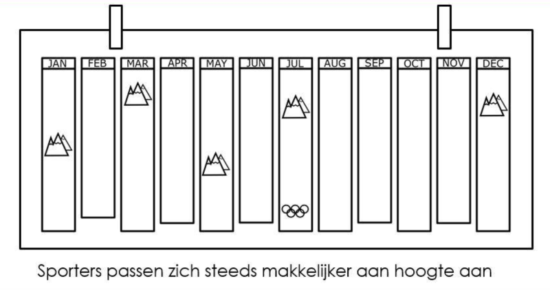
According to some scientists, the effect of altitude training is enhanced at every altitude stage. So it pays to go into the mountains several times a year. Altitude training has long been used by endurance athletes to perform better at sea level. The idea is simple: by training in thin air you make more epo hormone and more red blood cells, which improves the oxygen transport to the muscles and organs. In practice, a traditional altitude training is difficult to plan: athletes can train less intensively at height, become exhausted faster or sometimes get sick. In addition, the individual response at height differs greatly between athletes. Some athletes have to get used to altitude for a long time or quickly lose their temporarily improved condition when they return to sea level.
Three researchers, from Canada, Spain and Australia, combine the latest scientific knowledge with their years of experience in guiding top athletes. Their main advice for altitude training: plan for the longer term and go for multiple altitude internships per year.
What was already known?
- Altitude training can provide a conditional performance peak at sea level.
What's new?
- If an athlete goes on altitude training several times a year, the effect of the altitude training is amplified every time.
Repeat
The power of repetition applies to altitude training. Height adjustment is faster if athletes have stayed at height before, allowing them to train at level faster during their altitude training. Height training is also more effective if an athlete stays at height for several periods in a row. In order to take maximum advantage of altitude training, it is therefore necessary to plan several altitude internships. The researchers advise to draw up a multi-year plan: a four-year Olympic cycle is ideal for this. As an example, they give a schedule of an Olympic swimmer who spent no less than 66 weeks at height in 4 years.
Individual altitude training
The training that is done during an altitude training must fit the training cycle, competition planning and the individual goals of an athlete. Because athletes respond differently to altitude training, it is difficult to give general advice about the duration and content of an altitude training. Since athletes can train less intensively at height, it is wise to get the bulk of the training volume from low-intensity endurance training, interspersed with short, intensive training that can possibly be performed at a lower height. With successive heights, the athlete is expected to be able to train increasingly intensively and have less need to descend for more intensive sessions.
Non-responders
The researchers go so far as to argue that athletes who do not experience a performance improvement after height training, so-called non-responders, do not exist. They think this non-responders are only victims of poor planning and programming of altitude traineeships: for example, because they have only been on altitude trainees once, have been exposed to low oxygen pressure for too short or have trained too little or too intensively. According to the researchers, every endurance athlete should benefit from height training with the right approach.
Mujika I, Sharma AP, Stellingwerff T (2019). Contemporary periodization of altitude training for elite endurance athletes: a narrative review. Sports Med. Epub ahead of print. DOI: 10.1007 / s40279-019-01165-y.

